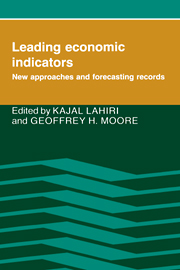Book contents
- Frontmatter
- Contents
- Preface
- List of contributors
- 1 Introduction
- PART I NEW CONCEPTS AND METHODS
- 2 Toward a theory of leading indicators
- 3 A time-series framework for the study of leading indicators
- 4 A probability model of the coincident economic indicators
- 5 An international application of Neftci's probability approach for signaling growth recessions and recoveries using turning point indicators
- 6 On predicting the stage of the business cycle
- 7 Bayesian methods for forecasting turning points in economic time-series: Sensitivity of forecasts to asymmetry of loss structures
- 8 New developments in leading indicators
- PART II FORECASTING RECORDS AND METHODS OF EVALUATION
- PART III NEW ECONOMIC INDICATORS
- Index
6 - On predicting the stage of the business cycle
Published online by Cambridge University Press: 05 June 2012
- Frontmatter
- Contents
- Preface
- List of contributors
- 1 Introduction
- PART I NEW CONCEPTS AND METHODS
- 2 Toward a theory of leading indicators
- 3 A time-series framework for the study of leading indicators
- 4 A probability model of the coincident economic indicators
- 5 An international application of Neftci's probability approach for signaling growth recessions and recoveries using turning point indicators
- 6 On predicting the stage of the business cycle
- 7 Bayesian methods for forecasting turning points in economic time-series: Sensitivity of forecasts to asymmetry of loss structures
- 8 New developments in leading indicators
- PART II FORECASTING RECORDS AND METHODS OF EVALUATION
- PART III NEW ECONOMIC INDICATORS
- Index
Summary
The business cycle and economic forecasting
Macroeconomic forecasts are traditionally stated as point estimates. Retrospective evaluations of forecasts usually assume that the cost of a forecast error increases with the arithmetic magnitude of the error. As a result, measures such as the root-mean-square error (RMSE) or the mean absolute error (MAE) are most often used to summarize forecast performance.
For many users, however, the traditional approach may not correspond with their own uses and evaluations of macro forecasts. The premise of this chapter is that it could be valuable for many users to accurately predict the stage of the business cycle several quarters ahead. For example, a government policymaker accountable to the electorate might well want the economy to be expanding in the quarter before an election; the actual levels of real GNP and other variables would be of secondary importance. Another example is that a producer of capital goods might expect two quite different sales levels to be associated with a particular level of real GNP, depending on whether the economy is expanding or contracting.
In short, when a variable such as real GNP is predicted, the relevant loss function may not be a simple linear or quadratic function of the forecast error. This chapter therefore proposes a measure to supplement the traditional summaries of forecast errors. The new measure attempts to capture the extent to which the stage of the business cycle is accurately predicted.
- Type
- Chapter
- Information
- Leading Economic IndicatorsNew Approaches and Forecasting Records, pp. 109 - 128Publisher: Cambridge University PressPrint publication year: 1991



